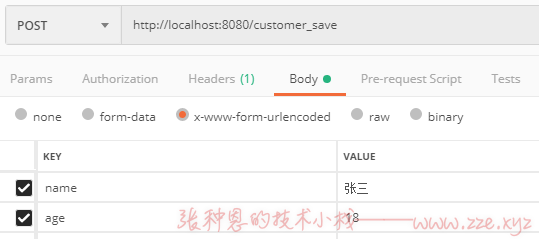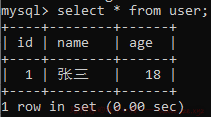方式一:保留 Hibernate 配置文件
1、编写实体映射文件:
<!-- com/zze/domain/User.hbm.xml -->
<?xml version="1.0" encoding="UTF-8" ?>
<!DOCTYPE hibernate-mapping PUBLIC
"-//Hibernate/Hibernate Mapping DTD 3.0//EN"
"http://www.hibernate.org/dtd/hibernate-mapping-3.0.dtd">
<hibernate-mapping>
<class name="com.zze.domain.User" table="user">
<id name="id" column="id">
<generator class="native"/>
</id>
<property name="name" column="name" length="32"/>
<property name="age" column="age"/>
</class>
</hibernate-mapping>
2、在 Hibernate 核心配置文件中引入实体映射文件:
<mapping resource="com/zze/domain/User.hbm.xml"/>
3、修改 Dao 代码,使用 Hibernate 提供的 Dao 模板类:
// com.zze.dao.impl.UserDaoImpl
package com.zze.dao.impl;
import com.zze.dao.UserDao;
import com.zze.domain.User;
import org.springframework.orm.hibernate5.support.HibernateDaoSupport;
// 使用 Hibernate 提供的 Dao 模板类
public class UserDaoImpl extends HibernateDaoSupport implements UserDao {
@Override
public void save(User user) {
this.getHibernateTemplate().save(user);
}
}
4、将 Hibernate 的核心工厂类实例交给 Spring 创建:
<!-- applicationContext.xml -->
<?xml version="1.0" encoding="UTF-8"?>
<beans xmlns="http://www.springframework.org/schema/beans"
xmlns:xsi="http://www.w3.org/2001/XMLSchema-instance"
xmlns:context="http://www.springframework.org/schema/context"
xmlns:aop="http://www.springframework.org/schema/aop"
xmlns:tx="http://www.springframework.org/schema/tx"
xsi:schemaLocation="http://www.springframework.org/schema/beans
http://www.springframework.org/schema/beans/spring-beans.xsd
http://www.springframework.org/schema/context
http://www.springframework.org/schema/context/spring-context.xsd
http://www.springframework.org/schema/aop
http://www.springframework.org/schema/aop/spring-aop.xsd
http://www.springframework.org/schema/tx
http://www.springframework.org/schema/tx/spring-tx.xsd">
<!--Spring 整合 Hibernate-->
<!--引入 Hibernate 配置信息-->
<bean name="sessionFactory" class="org.springframework.orm.hibernate5.LocalSessionFactoryBean">
<property name="configLocation" value="classpath:hibernate.cfg.xml"/>
</bean>
<!--
<bean name="hibernateTemplate" class="org.springframework.orm.hibernate5.HibernateTemplate">
<property name="sessionFactory" ref="sessionFactory"/>
</bean>
-->
<!-- 配置事务管理器 -->
<bean id="transactionManager" class="org.springframework.orm.hibernate5.HibernateTransactionManager">
<property name="sessionFactory" ref="sessionFactory"/>
</bean>
<!-- 开启注解事务 -->
<tx:annotation-driven transaction-manager="transactionManager"/>
<!--Spring 整合 Struts2-->
<!--
让 Spring 来创建 Action 实例
注意,Action 类要配置为多例
-->
<bean name="userAction" class="com.zze.web.action.UserAction" scope="prototype">
<property name="userService" ref="userService"/>
</bean>
<bean name="userService" class="com.zze.service.impl.UserServiceImpl">
<property name="userDao" ref="userDao"/>
</bean>
<bean name="userDao" class="com.zze.dao.impl.UserDaoImpl">
<property name="sessionFactory" ref="sessionFactory"/>
<!--
<property name="hibernateTemplate" ref="hibernateTemplate"/>
-->
</bean>
</beans>
5、测试:
<!-- com.zze.web.action.UserAction -->
package com.zze.web.action;
import com.opensymphony.xwork2.ActionSupport;
import com.opensymphony.xwork2.ModelDriven;
import com.zze.domain.User;
import com.zze.service.UserService;
public class UserAction extends ActionSupport implements ModelDriven<User> {
private User user = new User();
@Override
public User getModel() {
return user;
}
private UserService userService;
public void setUserService(UserService userService) {
this.userService = userService;
}
public String save() {
userService.save(user);
return NONE;
}
}


方式二:去除 Hibernate 配置文件
1、新建数据库连接信息属性文件:
# jdbc.properties
jdbc.driverClass=com.mysql.jdbc.Driver
jdbc.url=jdbc:mysql:///test
jdbc.username=root
jdbc.password=root
2、删除 Hibernate 配置文件 hibernate.cfg.xml,在 Spring 配置文件中完成 Hibernate 相关配置:
<!-- applicationContext.xml -->
<?xml version="1.0" encoding="UTF-8"?>
<beans xmlns="http://www.springframework.org/schema/beans"
xmlns:xsi="http://www.w3.org/2001/XMLSchema-instance"
xmlns:context="http://www.springframework.org/schema/context"
xmlns:aop="http://www.springframework.org/schema/aop"
xmlns:tx="http://www.springframework.org/schema/tx"
xsi:schemaLocation="http://www.springframework.org/schema/beans
http://www.springframework.org/schema/beans/spring-beans.xsd
http://www.springframework.org/schema/context
http://www.springframework.org/schema/context/spring-context.xsd
http://www.springframework.org/schema/aop
http://www.springframework.org/schema/aop/spring-aop.xsd
http://www.springframework.org/schema/tx
http://www.springframework.org/schema/tx/spring-tx.xsd">
<context:property-placeholder location="classpath:jdbc.properties"/>
<!--配置 C3P0 数据源-->
<bean name="dataSource" class="com.mchange.v2.c3p0.ComboPooledDataSource">
<property name="driverClass" value="${jdbc.driverClass}"/>
<property name="jdbcUrl" value="${jdbc.url}"/>
<property name="user" value="${jdbc.username}"/>
<property name="password" value="${jdbc.password}"/>
</bean>
<!--Spring 整合 Hibernate-->
<!--引入 Hibernate 配置信息-->
<bean name="sessionFactory" class="org.springframework.orm.hibernate5.LocalSessionFactoryBean">
<!-- 注入连接池 -->
<property name="dataSource" ref="dataSource"/>
<!-- 配置Hibernate的相关属性 -->
<property name="hibernateProperties">
<props>
<prop key="hibernate.dialect">org.hibernate.dialect.MySQLDialect</prop>
<prop key="hibernate.show_sql">true</prop>
<prop key="hibernate.format_sql">true</prop>
<prop key="hibernate.hbm2ddl.auto">update</prop>
</props>
</property>
<!-- 设置映射文件 -->
<property name="mappingResources">
<list>
<value>com/zze/domain/User.hbm.xml</value>
</list>
</property>
</bean>
<!--
<bean name="hibernateTemplate" class="org.springframework.orm.hibernate5.HibernateTemplate">
<property name="sessionFactory" ref="sessionFactory"/>
</bean>
-->
<!-- 配置事务管理器 -->
<bean id="transactionManager" class="org.springframework.orm.hibernate5.HibernateTransactionManager">
<property name="sessionFactory" ref="sessionFactory"/>
</bean>
<!-- 开启注解事务 -->
<tx:annotation-driven transaction-manager="transactionManager"/>
<!--Spring 整合 Struts2-->
<!--
让 Spring 来创建 Action 实例
注意,Action 类要配置为多例
-->
<bean name="userAction" class="com.zze.web.action.UserAction" scope="prototype">
<property name="userService" ref="userService"/>
</bean>
<bean name="userService" class="com.zze.service.impl.UserServiceImpl">
<property name="userDao" ref="userDao"/>
</bean>
<bean name="userDao" class="com.zze.dao.impl.UserDaoImpl">
<property name="sessionFactory" ref="sessionFactory"/>
<!--
<property name="hibernateTemplate" ref="hibernateTemplate"/>
-->
</bean>
</beans>
3、测试:
// com.zze.web.action.UserAction
package com.zze.web.action;
import com.opensymphony.xwork2.ActionSupport;
import com.opensymphony.xwork2.ModelDriven;
import com.zze.domain.User;
import com.zze.service.UserService;
public class UserAction extends ActionSupport implements ModelDriven<User> {
private User user = new User();
@Override
public User getModel() {
return user;
}
private UserService userService;
public void setUserService(UserService userService) {
this.userService = userService;
}
public String save() {
userService.save(user);
return NONE;
}
}


-de8bd8f33c3e44a59907dafe1884f228.png)


评论区